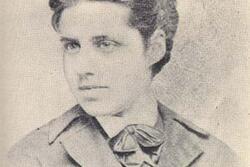China's Jewish Sanctuary City
Last month, in the waning days of Barack Obama’s presidency, I left America for a long-planned whirlwind tour of China with my Sinophile husband. My husband and I threw ourselves into our adventures, trying to forget that next time we set foot on American soil, it would be under a very different government.
Our first stop was a week-long visit to Shanghai. As a European history enthusiast/nerd, I arrived in the city determined to find whatever trace I could of the city’s former Jewish ghetto.
Yes, you read that right: Shanghai was the only city to not impose a quota on European Jewish refugees during World War II, and was consequently home to the only Jewish ghetto to survive the Holocaust. Approximately 20,000 European Jews fled east in the 1930s, taking refuge in the city's International Settlement among the exiled White Russians and British and French colonialists already living there. These refugees settled into a strange land, learning the language and customs, setting up ersatz European tailor shops and cafes, facing starvation, bombing, and threats from German officials after World War II broke out. Their story is marked by horror and also by heroism, such as in the journey of Laura Margolis, an American who traveled to Shanghai and advocated on behalf of the refugees at great risk to her personal safety.
Almost all of these refugees dispersed after the war, and not much remains of their ghetto. Shanghai is a city on the move; its population has quintupled in the past three decades, and it's not a place overly concerned with preserving or lionizing its historical architecture and neighborhoods. As I stood on Changyang Road in Hongkew, where the ghetto once lay, I was struck by how little it resembled the grainy pictures of the former community. Now, smog drifts around nondescript highrises and construction cranes, while tuktuks, electric motorbikes, and cars flood the wide, anonymous street.
But still, some traces remain. The Shanghai Jewish Refugees Museum stands on this road, housed in the community's former synagogue. At the museum, visitors can peruse a collection of furniture, suitcases, letters, and documents donated by the survivors, including copies of the Shanghai Jewish Chronicle, the community's main publication; placards advertising the tailors and cafes established by the refugee community; and passports stamped with a J and an Iron Cross. The museum also houses a copper memorial inscribed with the names of every refugee who fled to Shanghai.
Besides the museum, a handful of pre-war residences, jumbled with fluttering laundry and tangled electric wires, still stands on the road. And across the street looms the White Horse Inn, a Central European-style brick structure, built by obviously homesick refugees in imitation of an Austrian institution of the same name.
As I explored these few remnants of the blocks that once saved 20,000 lives, the strangest feeling crept up on me. It wasn't the oddity of standing among the remains of an imitation-European community in a Chinese city; it wasn't the strangeness of seeing Holocaust history in Asia.
No. It was the conviction that I should be able to see more places––many more places––like this, all over the world.
I should be able to tour the neighborhoods that sheltered hundreds of thousands of Jewish refugees in New York, Chicago, Boston, Montreal and Toronto, London and Manchester. But thanks to xenophobia, inaction, and fear, these neighborhoods never existed. Yes, America and Great Britain welcomed some refugees—but they also turned thousands more away. Ernest Heppner, a survivor of Shanghai’s ghetto, wrote in his memoir, Shanghai Refugee, that during his mad-dash escape from Europe, as he passed through the Suez Canal, British officials were reluctant to let him into the port even for one night, so loath were they to welcome stateless Jews into their empire.
In accepting only a fraction of European Jews, the other nations of the world were complicit in their destruction.
But my horror about this destruction-by-neglect isn’t confined to condemnation of the past. I’ve been back in America for a week, and already, our new president has fulfilled some of his most heinous campaign promises, including his executive order to halt immigration from Syria and restrict it from Muslim majority countries—places that are wracked by a horrific civil war, bombings and violence. As airports around the country detain travelers, as consulates around the world cancel interviews with the desperate and hopeful, as refugees scheduled to obtain visas have their dreams dashed, as remember this: our safety depends only on a happy accident of geography and birth year. Today it’s Muslims from wartorn Syria; seventy years ago, it was us. It could be us again. It could be anyone. For me, the Shanghai Jewish ghetto represents 20,000 lives spared. But it also represents the shadows of all the other communities that never existed because people held their safety and comfort so sacrosanct that they refused to compromise them ever-so-slightly to save hundreds of thousands of lives.
Let’s not let it happen again.








Respectfully suggest readers check out the very large Jewish settlements that are very real in each if these ciries: Chicago, etc.!
Also check out Montgomery County Maryland....Jews doing great. . .